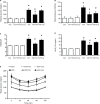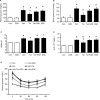Telmisartan is effective to ameliorate metabolic syndrome in rat model - a preclinical report
- PMID: 30584345
- PMCID: PMC6290862
- DOI: 10.2147/DMSO.S187092
Telmisartan is effective to ameliorate metabolic syndrome in rat model - a preclinical report
Abstract
Background: Metabolic syndrome (MS) is known to be associated with hypertension, insulin resistance, and dyslipidemia, and it raises the risk for cardiovascular diseases and diabetes mellitus. Telmisartan is used in clinic as an angiotensin II receptor blocker and it is also identified as activating peroxisome proliferator-activated receptors δ (PPARδ). Activation of PPARδ produced beneficial effects on fatty acid metabolism and glucose metabolism. This study aims to investigate the effects of telmisartan on the modulation of MS in rats fed a high-fat/high-sodium diet.
Methods: Rats were fed with a high-fat/high-sodium diet and received injections of streptozotocin at low dose to induce MS. Then, rats with MS were treated with telmisartan. The weight, glucose tolerance, and insulin sensitivity were measured. The lipid profiles were also obtained. The weights of retroperitoneal and epididymal fat pads were determined. The role of PPARδ in telmisartan treatment was identified in rats pretreated with the specific antagonist GSK0660.
Results: The results showed that telmisartan, but not losartan, significantly reduced plasma glucose and plasma insulin, and improved insulin resistance in rats with MS. Telmisartan also decreased blood pressure and lipids more significantly than losartan. Moreover, GSK0660 effectively reversed the effects of telmisartan in the MS rats. In the MS group, telmisartan activated PPARδ to enhance the levels of phosphorylated GLUT4 in muscle or the expression of phosphoenolpyruvate carboxykinase (PEPCK) in the liver, which was also abolished by GSK0660. Telmisartan is useful to ameliorate hypertension and insulin resistance in rats with MS. Telmisartan improves the insulin resistance through increased expression of GLUT4 and down-regulation of PEPCK via PPARδ-dependent mechanisms.
Conclusion: Telmisartan has been proven to ameliorate MS, particularly in the prediabetes state. Therefore, telmisartan is suitable to develop for the management of MS in clinics.
Keywords: GSK0660; PPARδ; diet; metabolic syndrome; telmisartan.
Conflict of interest statement
Disclosure The authors report no conflict of interests in this work.
Figures




Similar articles
-
Telmisartan improves cardiac fibrosis in diabetes through peroxisome proliferator activated receptor δ (PPARδ): from bedside to bench.Cardiovasc Diabetol. 2016 Aug 12;15(1):113. doi: 10.1186/s12933-016-0430-5. Cardiovasc Diabetol. 2016. PMID: 27519769 Free PMC article. Clinical Trial.
-
Telmisartan improves insulin resistance of skeletal muscle through peroxisome proliferator-activated receptor-δ activation.Diabetes. 2013 Mar;62(3):762-74. doi: 10.2337/db12-0570. Epub 2012 Dec 13. Diabetes. 2013. PMID: 23238297 Free PMC article.
-
Angiotensin II type 1 receptor-independent beneficial effects of telmisartan on dietary-induced obesity, insulin resistance and fatty liver in mice.Diabetologia. 2010 Aug;53(8):1727-31. doi: 10.1007/s00125-010-1744-6. Diabetologia. 2010. PMID: 20390403
-
Angiotensin-receptor blocking agents and the peroxisome proliferator-activated receptor-gamma system.Curr Hypertens Rep. 2005 Aug;7(4):240-3. doi: 10.1007/s11906-005-0019-y. Curr Hypertens Rep. 2005. PMID: 16061040 Review.
-
Novel approach to treat insulin resistance, type 2 diabetes, and the metabolic syndrome: simultaneous activation of PPARalpha, PPARgamma, and PPARdelta.Curr Diabetes Rev. 2005 Aug;1(3):299-307. doi: 10.2174/157339905774574365. Curr Diabetes Rev. 2005. PMID: 18220606 Review.
Cited by
-
Effect of fish oil and telmisartan on dehydroepiandrosterone-induced polycystic ovarian syndrome in rats: The role of oxidative stress, transforming growth factor beta-1, and nuclear factor kappa B.Food Sci Nutr. 2020 Aug 5;8(9):5149-5159. doi: 10.1002/fsn3.1819. eCollection 2020 Sep. Food Sci Nutr. 2020. PMID: 32994975 Free PMC article.
-
Synbiotic supplementation ameliorates anxiety and myocardial ischaemia-reperfusion injury in hyperglycaemic rats by modulating gut microbiota.Exp Physiol. 2024 Nov;109(11):1882-1895. doi: 10.1113/EP092052. Epub 2024 Sep 12. Exp Physiol. 2024. PMID: 39264256 Free PMC article.
-
Telmisartan versus metformin in downregulating myostatin gene expression and enhancing insulin sensitivity in the skeletal muscles of type 2 diabetic rat model.Front Pharmacol. 2023 Jul 28;14:1228525. doi: 10.3389/fphar.2023.1228525. eCollection 2023. Front Pharmacol. 2023. PMID: 37576807 Free PMC article.
References
-
- Misra A, Singhal N, Khurana L. Obesity, the metabolic syndrome, and type 2 diabetes in developing countries: role of dietary fats and oils. J Am Coll Nutr. 2010;29(3 Suppl):289S–301S. - PubMed
-
- Engin A. The definition and prevalence of obesity and metabolic syndrome. Adv Exp Med Biol. 2017;960:1–17. - PubMed
-
- Lakka HM, Laaksonen DE, Lakka TA, et al. The metabolic syndrome and total and cardiovascular disease mortality in middle-aged men. JAMA. 2002;288(21):2709–2716. - PubMed
-
- Hassannejad R, Kazemi I, Sadeghi M, et al. Longitudinal association of metabolic syndrome and dietary patterns: a 13-year prospective population-based cohort study. Nutr Metab Cardiovasc Dis. 2018;28(4):352–360. - PubMed
LinkOut - more resources
Full Text Sources

